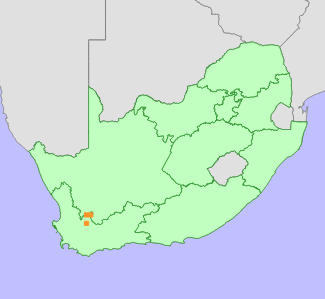|
Scientific Name | Haemanthus tristis Snijman |
Higher Classification | Monocotyledons |
Family | AMARYLLIDACEAE |
National Status |
Status and Criteria | Vulnerable D1 |
Assessment Date | 2004/07/20 |
Assessor(s) | D.A. Snijman & D. Raimondo |
Justification | Known from five sites, subpopulations consist of scattered bulbs growing in seasonal washes. Not threatened. |
Distribution |
Endemism | South African endemic |
Provincial distribution | Northern Cape, Western Cape |
Range | South-eastern Tanqua Karoo. |
Habitat and Ecology |
Major system | Terrestrial |
Major habitats | Tanqua Karoo, Tanqua Wash Riviere |
Description | Flat, seasonal washes in soils derived from Ecca shale. |
Threats |
| Habitat degradation |
Population |
Population trend | Stable |
Assessment History |
Taxon assessed |
Status and Criteria |
Citation/Red List version | | Haemanthus tristis Snijman | VU D1 | Raimondo et al. (2009) | | Haemanthus tristis Snijman | Lower Risk - Least Concern | Victor (2002) | | Haemanthus tristis Snijman | Rare | Hilton-Taylor (1996) | |
Bibliography |
Hilton-Taylor, C. 1996. Red data list of southern African plants. Strelitzia 4. South African National Botanical Institute, Pretoria.
Hilton-Taylor, C. Unpublished. Succulent Karoo Red Data List (version 1997 - in preparation). SANBI.
Raimondo, D., von Staden, L., Foden, W., Victor, J.E., Helme, N.A., Turner, R.C., Kamundi, D.A. and Manyama, P.A. 2009. Red List of South African Plants. Strelitzia 25. South African National Biodiversity Institute, Pretoria.
Snijman, D.A. 1984. A revision of the genus Haemanthus L. (Amaryllidaceae). Journal of South African Botany Supplement 12:1-139.
Snijman, D.A. 2013. Plants of the Greater Cape Floristic Region 2: The extra Cape flora. Strelitzia 30. South African National Biodiversity Institute, Pretoria.
Victor, J.E. 2002. South Africa. In: J.S. Golding (ed), Southern African plant Red Data Lists. Southern African Botanical Diversity Network Report 14 (pp. 93-120), SABONET, Pretoria.
|
Citation |
| Snijman, D.A. & Raimondo, D. 2004. Haemanthus tristis Snijman. National Assessment: Red List of South African Plants version . Accessed on 2025/08/22 |
 Comment on this assessment
Comment on this assessment


